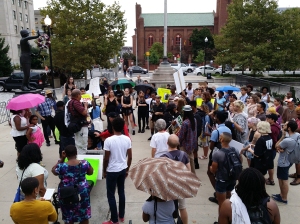Like many major metropolitan areas, the city of Baltimore has had a major police brutality problem. The recent police shooting in Ferguson as open the spotlight on the issue across the nation. In Baltimore, police brutality has been an ongoing issue for years. Only recently have officials started to address the problem after many families began protesting the deaths of loved ones that were victims of police brutality. Some of the more visible accounts have included the deaths of Tyrone West, Anthony Anderson and George King. Others have included beatings or attacks like the case of Kollin Truss (Baltimore Sun, 2014). Countless hours of meetings, protests, official letters to call for investigations and the released video from the Kollin Truss case has finally resulted in several visible steps to address the problem. These steps include a possible Department of Justice investigation and a new plan or report to deal with police brutality. Unfortunately, the city has a history of either implementing empty reforms or simply pushing the issue under the proverbial rug. Hopefully there will be real steps taken that ensure that police brutality will be effectively monitored and addressed with real investigations.

The Mayor and Police Commissioner addressing a forum on policing in Baltimore
What is being touted as a major plan to deal with police brutality, the Police Commissioner Batts and Mayor Rawlings-Blake have produced the report entitled “Preventing Harm”. In the Baltimore Sun article “Baltimore officials offer plan to curb police brutality”, the authors, Luke Broadwater and Mark Puente, describe the report as a 41 page document detailing a number of potential solutions that could be utilized to reduce the incidents of police brutality. Some of the solutions put forward include a call to increase internal affairs staffing, conduct a study on wearable cameras, utilizing more tasers, changing the current laws that sometimes protect rogue officers and a proposed new citizen’s police academy. While many of these options have potentially positive effects, there are many questions about their effectiveness in implementation.
In many ways this report has a number of fixes that appear good on paper. The problem is that the solutions might not work as effectively as there are promised. For instance, the proposal of utilizing wearable cameras could be a good option. It could bring greater accountability and a more candid view of how police interact with people on the streets. Unfortunately, there could also be several problems with their use. Would such video recordings be made available to the public? Who would have access to the video recordings? Would civilians be able to request recordings or would they be buried under “ongoing investigations” that seem to go one forever? There is also the issue of privacy and surveillance. Would such recordings be abused or mishandled? These problems would need to be addressed fairly quickly if they were to be implemented effectively.

Numerous protests over police brutality have brought the issue to the front headlines
While the plan to implementation can be a good step in creating an atmosphere of greater accountability, would all officers wear them? Several proposals have been put forward that limit their use to either new recruits just graduating from the police academy or phasing in their use. There would need to be a full implementation if they were to be utilized fully. Simply creating a lengthy timeframe for implementing such devices could render their use moot.
Another problem is the solution potentially utilizing more numbers of tasers. For some the idea of non-lethal type weapons might appear to be an effective way to reduce police killings. The reality is far different. There are a number of cases including the death of Tyrone West and Kollin Truss where tasers were used as essentially devices of torture. Do we really want to have police officers going around essentially electrocuting residents, even those that are not charged with a crime? Tasers are also potentially deadly, even some people with healthy bodies. In many instances, officers tend to overuse tasers with the belief that they are “safe” or at least leave no marks for potential investigations. Far from reducing incidents of police brutality, tasers could actually increase them. They could also increase the fear factor and divide that the community has for the police as this time.
Beyond these problems, there is also a lack of in-depth review of how current police brutality cases are handled. There is a critical need to reform the current civilian based review board system. According to the article, “Baltimore police review board called irrelevant, ineffective”, the review board is often understaffed with vacancies, has its recommendations ignored by the police and constant complaints about its inefficiencies (Baltimore Sun, 2013). While the current Mayor and Police Commissioner have taken steps to reform the review the board, there are still some critical changes needed. One is a streamlined process to ensure easier reporting of police related crimes. Another is greater transparency for the general public. Many cases are often kept hidden or secret from the public eyes during review board investigations. Then there are the problems where cases were either ignored or swept under the rug. Even when the review board acts on a case, it doesn’t necessarily bring charges against officers, making it harder for disciplinary actions to be enacted.

A group of police cars can cause fear among the community
A second problem is the lack of action by the state attorney’s office. Even in cases where victims were killed by the police without cause with a great deal of evidence, there is often little effort to prosecute the officers involved. In the case of Anthony Anderson, police officers physically threw the man onto the ground killing him with dozens of onlookers. His death was even ruled a homicide by the coroner’s office. Yet none of the officers were punished. With the case of Tyrone West involving multiple officers beating the man to death over an unwarranted traffic stop, none were ever held accountable. Worse, there were attempts at stonewalling the investigation over his death, delays in performing the autopsy and questions about the overall transparency of the investigation process itself. Essentially the report ignores this problem of a lack of prosecution by the state’s attorney. Even when there is evidence to support the complaint against an officer, there are often little in the way of justice involved.
A third issue is the problem of transparency. While the mayor and police commissioner promise greater accountability, will there be real reforms for transparency? Only in the last year or two have official statistics been opened to the public. These have included reports of police misconduct, legal settlements for victims of police brutality and disciplinary reports for rogue officers. Unfortunately, there is very little that has been released about past incidents of police brutality, making it harder to discern the real facts about the issue in Baltimore. A full level of transparency would be another good step for helping to address the issue of police brutality as well as helping to re-establish a great trust of the police in the community.
To be fair there are some steps that could be positive changes for the police department. Commissioner Batts would like to reform state level protections that often cover the actions of rogue police officers. Currently, officers can be suspended with pay during any investigations. Unless they are formally charged with a felony, police officers cannot be dismissed or punished within the police department. Batts would like to see a change in this process and bring greater power to discipline officers within the police department.

Community trust needs to be regained with the city police
Perhaps the biggest positive outcome of the report is the simple fact that city officials are finally addressing the problem of police brutality with real reforms. In numerous times over the city’s history, there has been little real reform to address the problem. Bringing the issue out in public debate, making everyone aware of the problem and hopefully talking about real plans to reform the current system are positive steps in the right direction. The question is whether these steps are enough. In some ways they may not be with further actions needed for change.
Perhaps on a deeper level, there is a foundation issue that is not always talked about. That is the issue of trust between the police and the community. Part of this problem comes from historic problems of abuse, misconduct as well as racial profiling. There is also the loss of trust that occurred with the implementation of O’Malley’s “Zero tolerance” which resulted in thousands of arrests for crimes that were either dismissed or ultimately considered trivial. This environment, coupled a history of police misconduct, helped to create the current environment where there is little trust with the city police. While Mayor Rawlings-Blake has stated her intentions to change this issue of trust, it will take further actions to do so.
In the end, reducing the incidents of police brutality may take more than what was detailed in the steps revealed in the “Reduce Harm” report produced by Police Commissioner Batts. It’s going to take both concrete actions as well as ongoing efforts to help change how police brutality is handled in the city. Only by making investigations more transparent, changing how officers are disciplined and implementing effective public review polices can the problem start to be addressed. While technological aids such as wearable cameras can be beneficial, they are not necessarily the ultimate answer. There is no quick fix to the problem. Our city requires an ongoing effort that will take years if properly implemented. Only time will tell if the city can rise to the challenge and ensure a proper policing system that does not victimize its own citizens.





